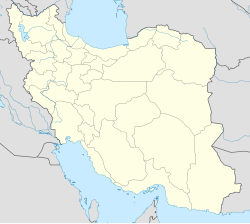Sefid Chah
Sefid Chah
Persian: سفيدچاه | |
|---|---|
Village | |
 Sefid Chah Cemetery | |
| Coordinates: 36°36′06″N 53°53′06″E / 36.60167°N 53.88500°E[1] | |
| Country | Iran |
| Province | Mazandaran |
| County | Behshahr |
| District | Yaneh Sar |
| Rural District | Shohada |
| Population (2016)[2] | |
• Total | 137 |
| Time zone | UTC+3:30 (IRST) |
Sefid Chah (Persian: سفيدچاه, Mazanderani: اسپه چاه)[a] is a village in, and the capital of, Shohada Rural District, Yaneh Sar District, Behshahr County, Mazandaran province, Iran.[4] The literal meaning of Sefid Chah is The White Well The reason for naming the village is the white soil that is seen in the cemetery due to the presence of lime.
Demographics
[edit]Population
[edit]At the time of the 2006 National Census, the village's population was 99 in 26 households.[5] The following census in 2011 counted 351 people in 55 households.[6] The 2016 census measured the population of the village as 137 people in 47 households.[2]
Cemetery
[edit]The old cemetery of Sefid Chah, was registered as a national monument of Iran on 8 March 2003. The cemetery dates back to the Timurid period and is considered one of the first Muslim cemeteries in Iran.
According to research and studies conducted by various soil research institutes, the soil of this cemetery contains large amounts of lime, and bodies in this type of soil decompose over a longer period of time than other types of cemetery soil. It is believed by the people of this village that if they are buried in this cemetery, their bodies will remain intact or will not suffer any damage.
The gender of the people buried there is indicated in a special way. If there is a shape of a double-headed shoulder on the stone installed on the grave, the grave belongs to a man, and if there is a shape of a single-headed shoulder on the gravestone, the person buried in that place is a woman.[7]
See also
[edit]Notes
[edit]References
[edit]- ^ OpenStreetMap contributors (21 October 2024). "Sefid Chah, Behshahr County" (Map). OpenStreetMap (in Persian). Retrieved 21 October 2024.
- ^ a b Census of the Islamic Republic of Iran, 1395 (2016): Mazandaran Province. amar.org.ir (Report) (in Persian). The Statistical Center of Iran. Archived from the original (Excel) on 7 October 2021. Retrieved 19 December 2022.
- ^ Sefid Chah can be found at GEOnet Names Server, at this link, by opening the Advanced Search box, entering "48185" in the "Unique Feature Id" form, and clicking on "Search Database".
- ^ Mousavi, Mirhossein (27 October 2013) [Approved 22 April 1987]. Creation and establishment of 10 rural districts including villages, farms and places in Behshahr County under Mazandaran province. rc.majlis.ir (Report) (in Persian). Ministry of the Interior, Council of Ministers. Proposal 53.1.11522; Notification 111066/T263. Archived from the original on 27 October 2013. Retrieved 15 January 2024 – via Research Center of the System of Laws of the Islamic Council of the Farabi Library of Mobile Users.
- ^ Census of the Islamic Republic of Iran, 1385 (2006): Mazandaran Province. amar.org.ir (Report) (in Persian). The Statistical Center of Iran. Archived from the original (Excel) on 20 September 2011. Retrieved 25 September 2022.
- ^ Census of the Islamic Republic of Iran, 1390 (2011): Mazandaran Province. irandataportal.syr.edu (Report) (in Persian). The Statistical Center of Iran. Archived from the original (Excel) on 19 January 2023. Retrieved 19 December 2022 – via Iran Data Portal, Syracuse University.
- ^ ""Safid Chah", a cemetery full of mysteries". Isna (in Persian). Iran's students news agency. 8 January 2024. Retrieved 6 August 2025.

